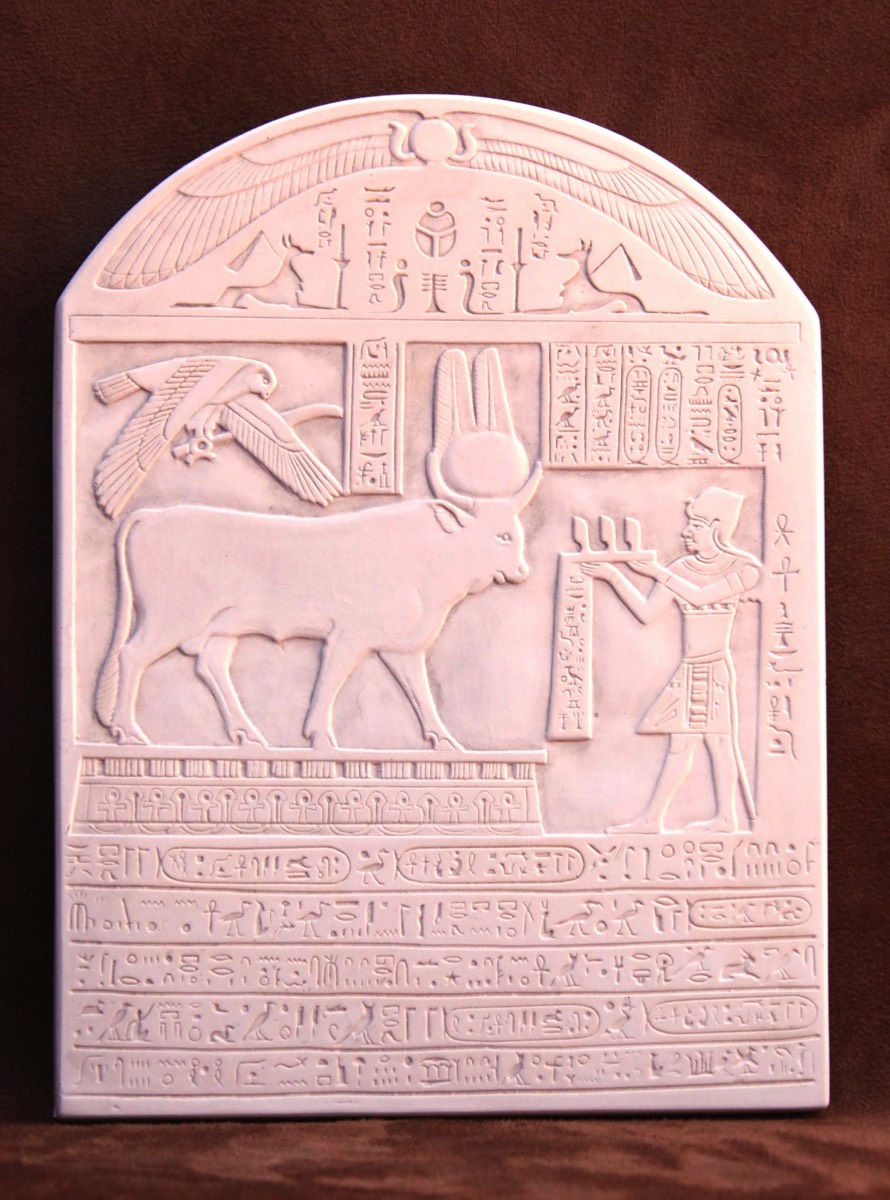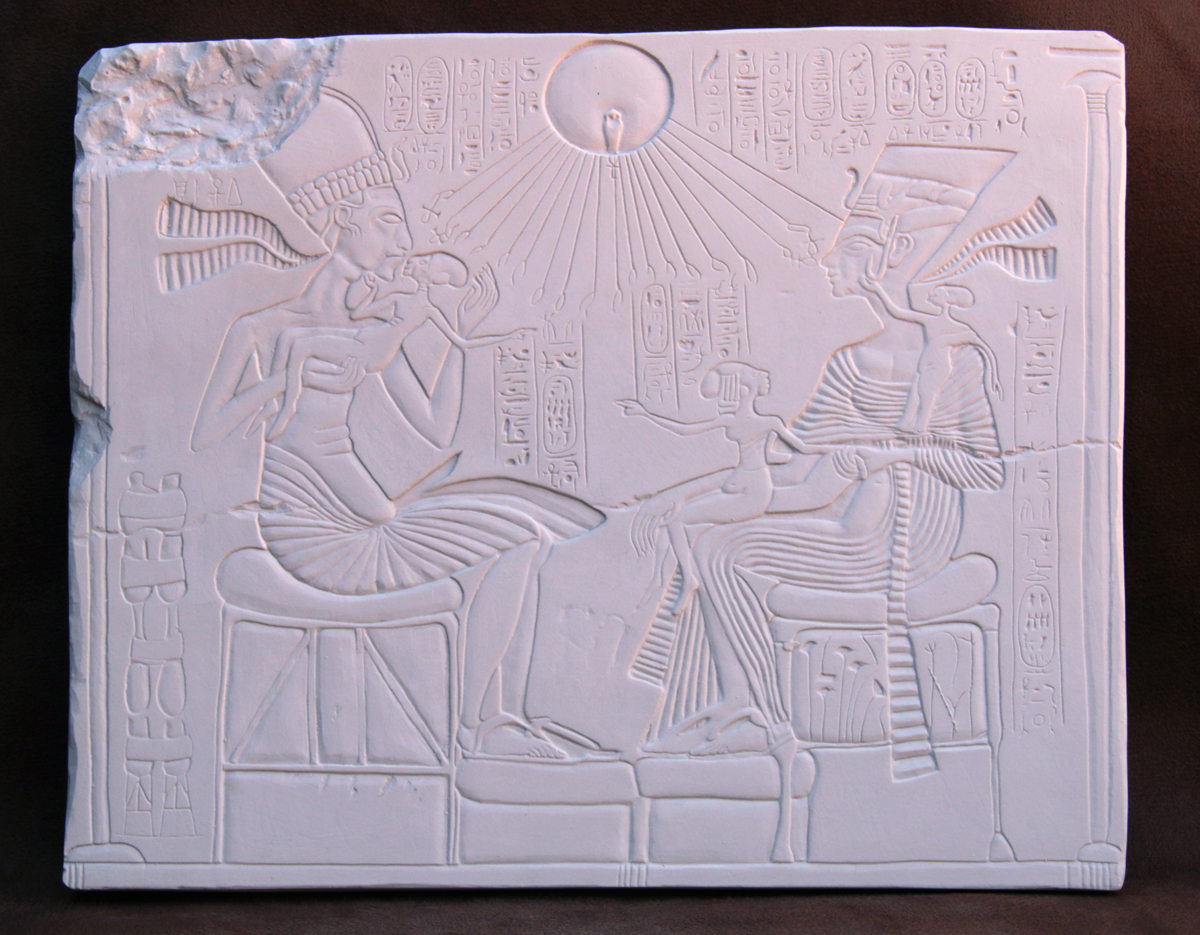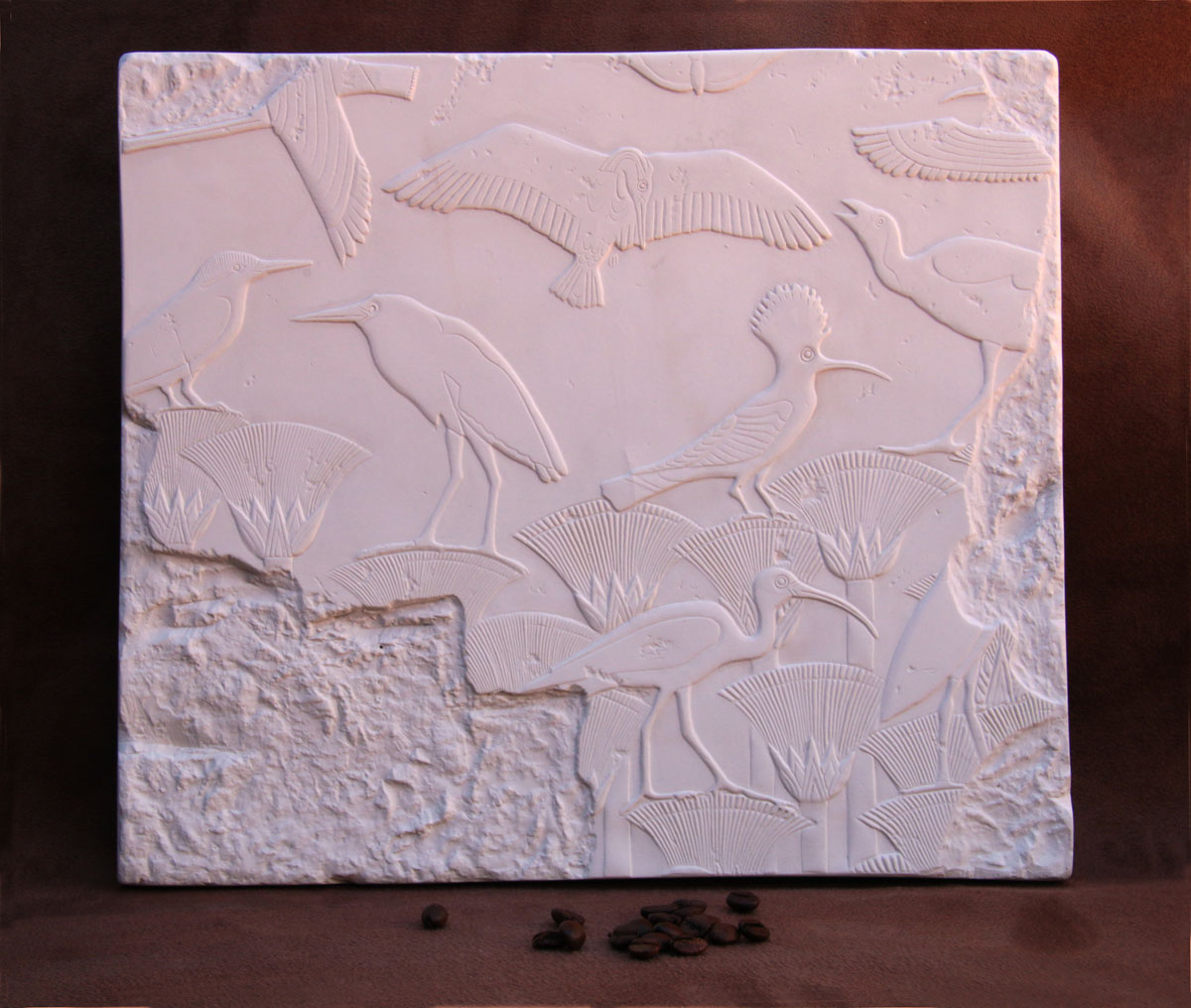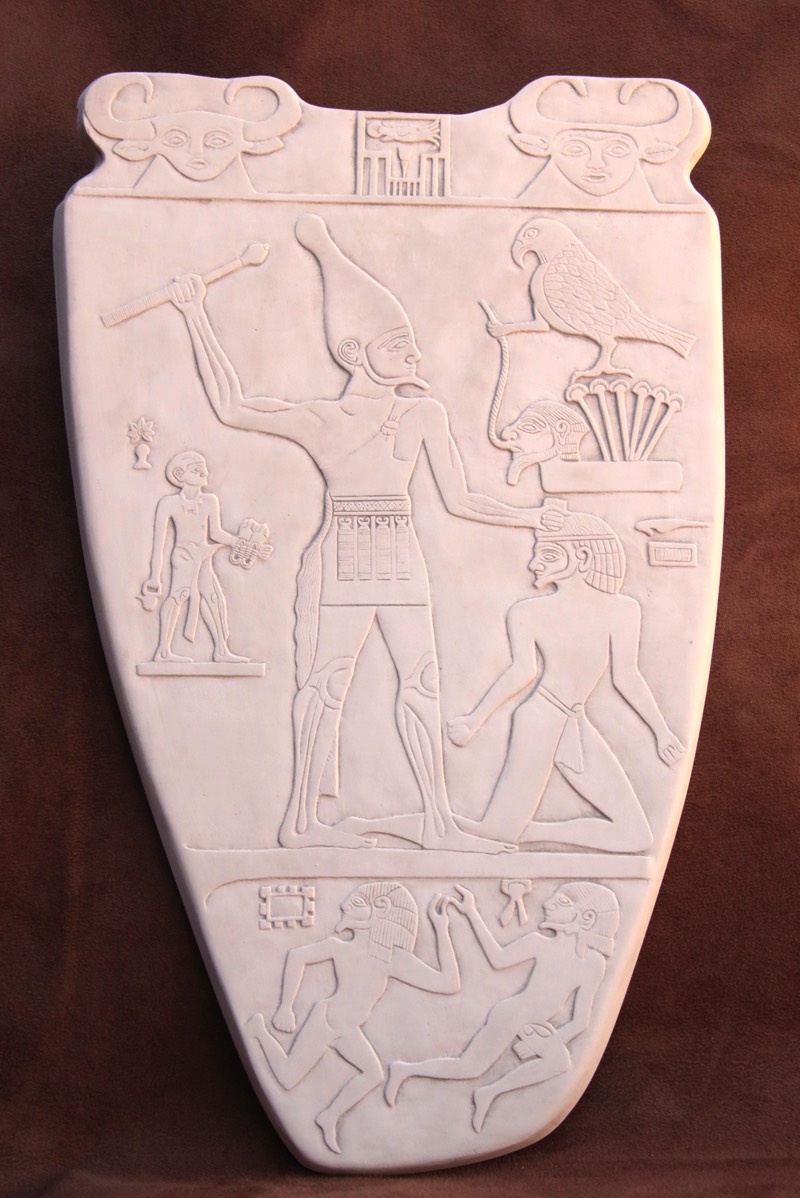
Egyptian Plaques Collection
Apis the Bull (Egyptian Plaque in plaster)
The original can be viewed at the British Museum being a round-topped sandstone stela divided into three registers:
1 - Winged sun-disc with pendent crowned uraei and jackals with flails below.
2 - Scene of Ptolemy II wearing the double crown offering to the Buchis Bull.
3 - Four lines of Hieroglyphic text recording the death of the sacred Buchis bull.
More Info
He presents an offering tray with three bread loaves shaped like reed leaves, one of which is damaged. An incense burner stands before the bull, who wears a sun-disc with double-plumes, and a stands on a platform.
Above the incense burner is a column intended for text, but no trace of inscription is evident and it may have been left blank. On the left, over the figure of the bull, is a second winged sun-disc, smaller and with unusually positioned wings, more often seen on hovering Horus falcons.
Despite the rather poor quality of the stone, the musculature of the king’s knees and the bull’s legs are indicated, and their faces are relatively modelled. The king’s face is somewhat rounded and fleshy. The stela is chipped around the edges.
Height: 210mm
Width: 155mm
Depth: 15mm
Above the incense burner is a column intended for text, but no trace of inscription is evident and it may have been left blank. On the left, over the figure of the bull, is a second winged sun-disc, smaller and with unusually positioned wings, more often seen on hovering Horus falcons.
Despite the rather poor quality of the stone, the musculature of the king’s knees and the bull’s legs are indicated, and their faces are relatively modelled. The king’s face is somewhat rounded and fleshy. The stela is chipped around the edges.
Height: 210mm
Width: 155mm
Depth: 15mm
Akhenaten, Nefertiti, and three daughters Plaque
Amarna period, 18th dynasty, c.1350 BCE
More Info
House Altar depicting Akhenaten, Nefertiti and Three of their Daughters, limestone, New Kingdom.
This piece was meant to be a house altar. the iconography of Aten and the depiction of the royal family of Akhenaten was propagated to encourage people to embrace the new monotheistic religion.
Works such as this relief carving were present and central to everyday life; the house altar serves a practical function as well as an artistic one, so the underlying message becomes present and visible in the family's daily life.
Height: 215mm
Width: 255mm
Depth: 15mm
This piece was meant to be a house altar. the iconography of Aten and the depiction of the royal family of Akhenaten was propagated to encourage people to embrace the new monotheistic religion.
Works such as this relief carving were present and central to everyday life; the house altar serves a practical function as well as an artistic one, so the underlying message becomes present and visible in the family's daily life.
Height: 215mm
Width: 255mm
Depth: 15mm
Birds and Papyrus Plaque
Jean-Philippe Lauer (1902 – 2001), was a French architect and prominent Egyptologist.
Jean-Philippe Lauer (1902 – 2001), was a French architect and prominent Egyptologist.
More Info
This limestone relief was unearthed during Lauer's 1948 excavations of the upper temple of the funerary complex of Userkaf, the first king of the 5th Dynasty.
The piece depicts several birds; the pied kingfisher, purple gallinule, the striped hoopoe, the sacred ibis, the night heron and the European kingfisher.
Height: 245mm
Width:280mm
Depth: 186mm
The piece depicts several birds; the pied kingfisher, purple gallinule, the striped hoopoe, the sacred ibis, the night heron and the European kingfisher.
Height: 245mm
Width:280mm
Depth: 186mm
Palette of King Narmer
Some artefacts are of such vital importance to our understanding of ancient cultures that they are truly unique and utterly irreplaceable.
Discovered among a group of sacred implements ritually buried in a deposit within an early temple of the falcon god Horus at the site of Hierakonpolis (the capital of Egypt during the pre-dynastic period), this large ceremonial object is one of the most important artefacts from the dawn of Egyptian civilisation.
Some artefacts are of such vital importance to our understanding of ancient cultures that they are truly unique and utterly irreplaceable.
Discovered among a group of sacred implements ritually buried in a deposit within an early temple of the falcon god Horus at the site of Hierakonpolis (the capital of Egypt during the pre-dynastic period), this large ceremonial object is one of the most important artefacts from the dawn of Egyptian civilisation.
More Info
Discovered among a group of sacred implements ritually buried in a deposit within an early temple of the falcon god Horus at the site of Hierakonpolis (the capital of Egypt during the pre-dynastic period), this large ceremonial object is one of the most important artifacts from the dawn of Egyptian civilization.
The beautifully carved palette, 63.5 cm (more than 2 feet) in height and made of smooth greyish-green siltstone, is decorated on both faces with detailed low relief.
These scenes show a king, identified by name as Narmer, and a series of ambiguous scenes that have been difficult to interpret and have resulted in a number of theories regarding their meaning.
Height: 380mm
Width: 230mm
Depth: 15mm
The beautifully carved palette, 63.5 cm (more than 2 feet) in height and made of smooth greyish-green siltstone, is decorated on both faces with detailed low relief.
These scenes show a king, identified by name as Narmer, and a series of ambiguous scenes that have been difficult to interpret and have resulted in a number of theories regarding their meaning.
Height: 380mm
Width: 230mm
Depth: 15mm
Egyptian Plaques Collection
Apis the Bull (Egyptian Plaque in plaster)
The original can be viewed at the British Museum being a round-topped sandstone stela divided into three registers:
1 - Winged sun-disc with pendent crowned uraei and jackals with flails below.
2 - Scene of Ptolemy II wearing the double crown offering to the Buchis Bull.
3 - Four lines of Hieroglyphic text recording the death of the sacred Buchis bull.
More Info
He presents an offering tray with three bread loaves shaped like reed leaves, one of which is damaged. An incense burner stands before the bull, who wears a sun-disc with double-plumes, and a stands on a platform.
Above the incense burner is a column intended for text, but no trace of inscription is evident and it may have been left blank. On the left, over the figure of the bull, is a second winged sun-disc, smaller and with unusually positioned wings, more often seen on hovering Horus falcons.
Despite the rather poor quality of the stone, the musculature of the king’s knees and the bull’s legs are indicated, and their faces are relatively modelled. The king’s face is somewhat rounded and fleshy. The stela is chipped around the edges.
Height: 210mm
Width: 155mm
Depth: 15mm
Above the incense burner is a column intended for text, but no trace of inscription is evident and it may have been left blank. On the left, over the figure of the bull, is a second winged sun-disc, smaller and with unusually positioned wings, more often seen on hovering Horus falcons.
Despite the rather poor quality of the stone, the musculature of the king’s knees and the bull’s legs are indicated, and their faces are relatively modelled. The king’s face is somewhat rounded and fleshy. The stela is chipped around the edges.
Height: 210mm
Width: 155mm
Depth: 15mm
Akhenaten, Nefertiti, and three daughters Plaque
Amarna period, 18th dynasty, c.1350 BCE
More Info
House Altar depicting Akhenaten, Nefertiti and Three of their Daughters, limestone, New Kingdom.
This piece was meant to be a house altar. the iconography of Aten and the depiction of the royal family of Akhenaten was propagated to encourage people to embrace the new monotheistic religion.
Works such as this relief carving were present and central to everyday life; the house altar serves a practical function as well as an artistic one, so the underlying message becomes present and visible in the family's daily life.
Height: 215mm
Width: 255mm
Depth: 15mm
This piece was meant to be a house altar. the iconography of Aten and the depiction of the royal family of Akhenaten was propagated to encourage people to embrace the new monotheistic religion.
Works such as this relief carving were present and central to everyday life; the house altar serves a practical function as well as an artistic one, so the underlying message becomes present and visible in the family's daily life.
Height: 215mm
Width: 255mm
Depth: 15mm
Birds and Papyrus Plaque
Jean-Philippe Lauer (1902 – 2001), was a French architect and prominent Egyptologist.
Jean-Philippe Lauer (1902 – 2001), was a French architect and prominent Egyptologist.
More Info
This limestone relief was unearthed during Lauer's 1948 excavations of the upper temple of the funerary complex of Userkaf, the first king of the 5th Dynasty.
The piece depicts several birds; the pied kingfisher, purple gallinule, the striped hoopoe, the sacred ibis, the night heron and the European kingfisher.
Height: 245mm
Width:280mm
Depth: 186mm
The piece depicts several birds; the pied kingfisher, purple gallinule, the striped hoopoe, the sacred ibis, the night heron and the European kingfisher.
Height: 245mm
Width:280mm
Depth: 186mm
Palette of King Narmer
Some artefacts are of such vital importance to our understanding of ancient cultures that they are truly unique and utterly irreplaceable.
Discovered among a group of sacred implements ritually buried in a deposit within an early temple of the falcon god Horus at the site of Hierakonpolis (the capital of Egypt during the pre-dynastic period), this large ceremonial object is one of the most important artefacts from the dawn of Egyptian civilisation.
Some artefacts are of such vital importance to our understanding of ancient cultures that they are truly unique and utterly irreplaceable.
Discovered among a group of sacred implements ritually buried in a deposit within an early temple of the falcon god Horus at the site of Hierakonpolis (the capital of Egypt during the pre-dynastic period), this large ceremonial object is one of the most important artefacts from the dawn of Egyptian civilisation.
More Info
Discovered among a group of sacred implements ritually buried in a deposit within an early temple of the falcon god Horus at the site of Hierakonpolis (the capital of Egypt during the pre-dynastic period), this large ceremonial object is one of the most important artifacts from the dawn of Egyptian civilization.
The beautifully carved palette, 63.5 cm (more than 2 feet) in height and made of smooth greyish-green siltstone, is decorated on both faces with detailed low relief.
These scenes show a king, identified by name as Narmer, and a series of ambiguous scenes that have been difficult to interpret and have resulted in a number of theories regarding their meaning.
Height: 380mm
Width: 230mm
Depth: 15mm
The beautifully carved palette, 63.5 cm (more than 2 feet) in height and made of smooth greyish-green siltstone, is decorated on both faces with detailed low relief.
These scenes show a king, identified by name as Narmer, and a series of ambiguous scenes that have been difficult to interpret and have resulted in a number of theories regarding their meaning.
Height: 380mm
Width: 230mm
Depth: 15mm






